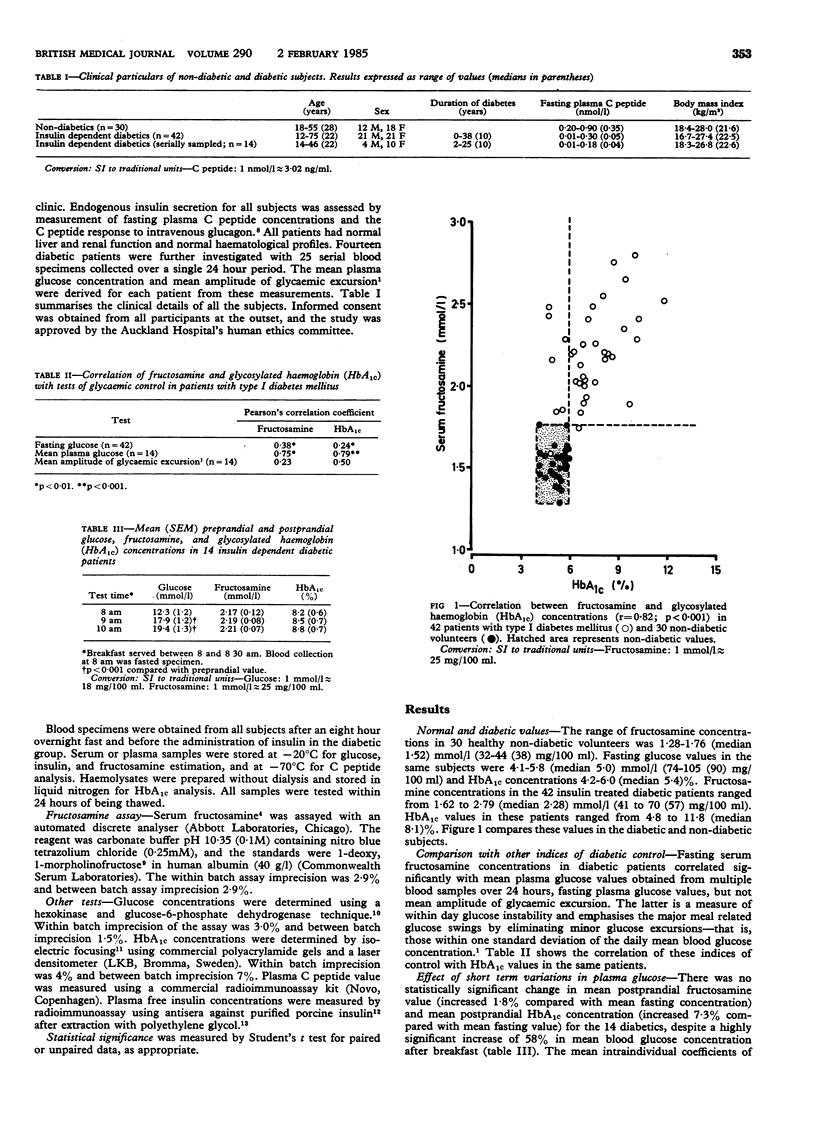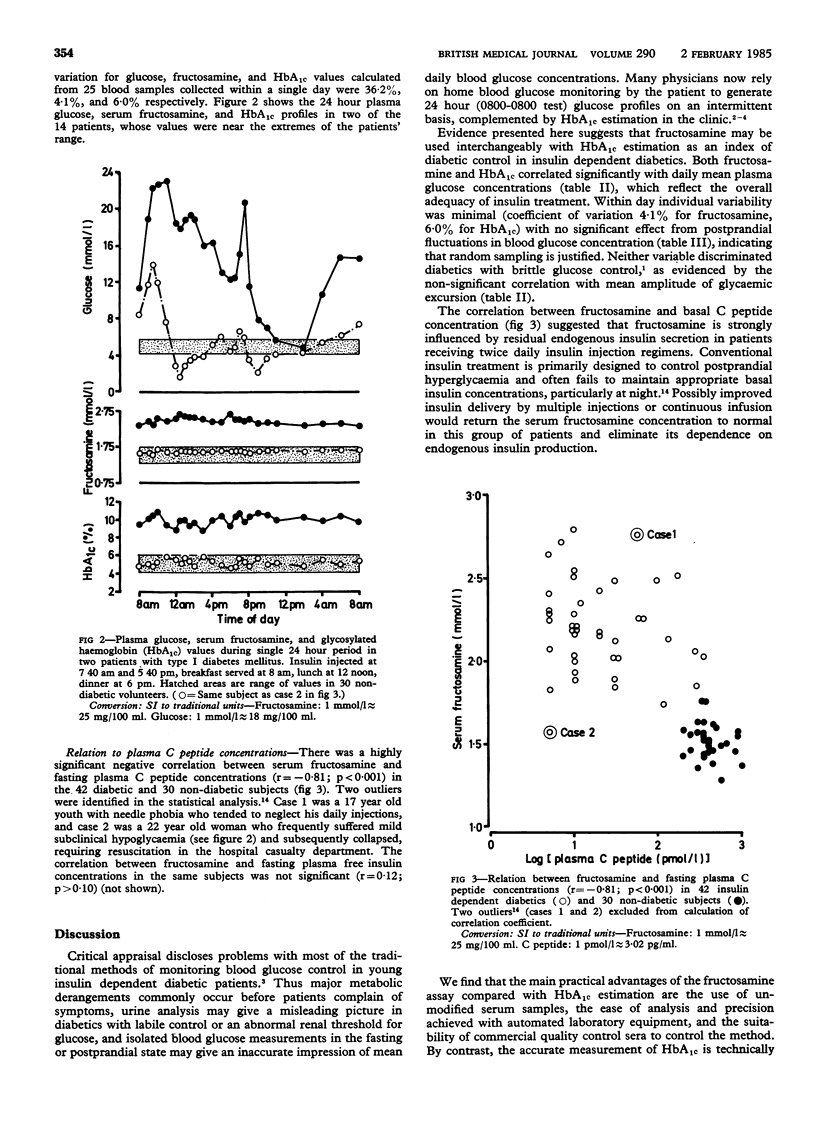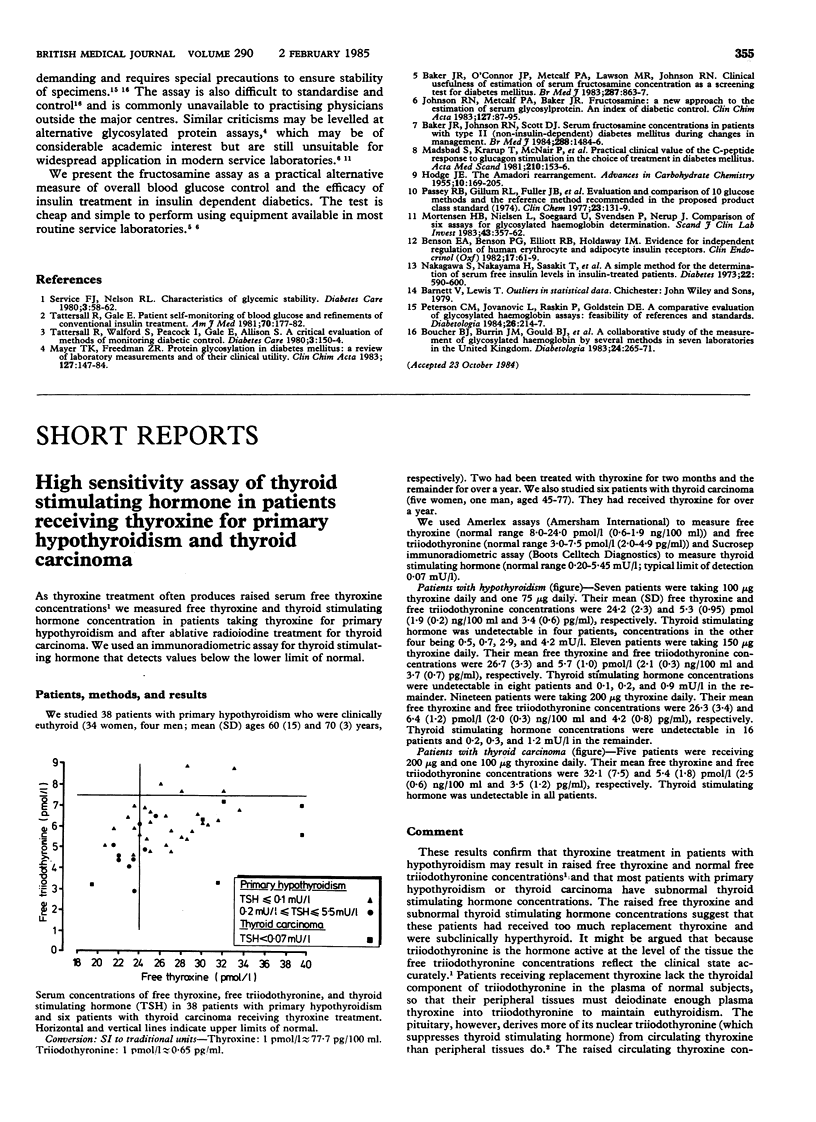Abstract
Serum fructosamine activity was studied in 42 patients with type I (insulin dependent) diabetes mellitus and 30 non-diabetic volunteers as an index of blood glucose control. There was a significant correlation both between fructosamine and glycosylated haemoglobin values (r = 0.82) and between fructosamine and the fasting C peptide concentration (r = -0.81). Test results in 14 of the diabetics reflected the mean plasma glucose concentration calculated from 25 serial estimations in a single 24 hour period (r = 0.75; p less than 0.01) but not the mean amplitude of glycaemic excursion (r = 0.23; p greater than 0.05). Fructosamine concentrations measured in these multiple blood specimens did not change significantly throughout the day (mean coefficient of variation 4.1%) despite wide variability of the respective plasma glucose concentrations (mean coefficient of variation 36.2%). It is concluded that a single random serum sample analysed for fructosamine concentration provides a simple and reliable assessment of glucose homoeostasis in patients with type I diabetes mellitus.
Full text
PDF



Selected References
These references are in PubMed. This may not be the complete list of references from this article.
- Baker J. R., Johnson R. N., Scott D. J. Serum fructosamine concentrations in patients with type II (non-insulin-dependent) diabetes mellitus during changes in management. Br Med J (Clin Res Ed) 1984 May 19;288(6429):1484–1486. doi: 10.1136/bmj.288.6429.1484. [DOI] [PMC free article] [PubMed] [Google Scholar]
- Baker J. R., O'Connor J. P., Metcalf P. A., Lawson M. R., Johnson R. N. Clinical usefulness of estimation of serum fructosamine concentration as a screening test for diabetes mellitus. Br Med J (Clin Res Ed) 1983 Sep 24;287(6396):863–867. doi: 10.1136/bmj.287.6396.863. [DOI] [PMC free article] [PubMed] [Google Scholar]
- Benson E. A., Gales-Benson P., Elliott R. B., Holdaway I. M. Evidence for independent regulation of human erythrocyte and adipocyte insulin receptors. Clin Endocrinol (Oxf) 1982 Jul 1;17(1):61–69. doi: 10.1111/j.1365-2265.1982.tb02634.x. [DOI] [PubMed] [Google Scholar]
- Boucher B. J., Burrin J. M., Gould B. J., John P. N., Lewis G., Owens C., Paisey R., Pennock C. A., Poon P. Y., Ross I. S. A collaborative study of the measurement of glycosylated haemoglobin by several methods in seven laboratories in the United Kingdom. Diabetologia. 1983 Apr;24(4):265–271. doi: 10.1007/BF00282711. [DOI] [PubMed] [Google Scholar]
- HODGE J. E. The Amadori rearrangement. Adv Carbohydr Chem. 1955;10:169–205. doi: 10.1016/s0096-5332(08)60392-6. [DOI] [PubMed] [Google Scholar]
- Johnson R. N., Metcalf P. A., Baker J. R. Fructosamine: a new approach to the estimation of serum glycosylprotein. An index of diabetic control. Clin Chim Acta. 1983 Jan 7;127(1):87–95. doi: 10.1016/0009-8981(83)90078-5. [DOI] [PubMed] [Google Scholar]
- Madsbad S., Krarup T., McNair P., Christiansen C., Faber O. K., Transbøl I., Binder C. Practical clinical value of the C-peptide response to glucagon stimulation in the choice of treatment in diabetes mellitus. Acta Med Scand. 1981;210(3):153–156. doi: 10.1111/j.0954-6820.1981.tb09793.x. [DOI] [PubMed] [Google Scholar]
- Mayer T. K., Freedman Z. R. Protein glycosylation in diabetes mellitus: a review of laboratory measurements and of their clinical utility. Clin Chim Acta. 1983 Jan 24;127(2):147–184. doi: 10.1016/s0009-8981(83)80002-3. [DOI] [PubMed] [Google Scholar]
- Mortensen H. B., Nielsen L., Søegaard U., Svendsen P. A., Nerup J. Comparison of six assays for glycosylated haemoglobin determination. Scand J Clin Lab Invest. 1983 Sep;43(5):357–362. [PubMed] [Google Scholar]
- Nakagawa S., Nakayama H., Sasaki T., Yoshino K., Yu Y. Y. A simple method for the determination of serum free insulin levels in insulin-treated patients. Diabetes. 1973 Aug;22(8):590–600. doi: 10.2337/diab.22.8.590. [DOI] [PubMed] [Google Scholar]
- Passey R. B., Gillum R. L., Fuller J. B., Urry F. M., Giles M. L. Evaluation and comparison of 10 glucose methods and the reference method recommended in the proposed product class standard (1974). Clin Chem. 1977 Jan;23(1):131–139. [PubMed] [Google Scholar]
- Peterson C. M., Jovanovic L., Raskin P., Goldstein D. E. A comparative evaluation of glycosylated haemoglobin assays: feasibility of references and standards. Diabetologia. 1984 Mar;26(3):214–217. doi: 10.1007/BF00252410. [DOI] [PubMed] [Google Scholar]
- Service F. J., Nelson R. L. Characteristics of glycemic stability. Diabetes Care. 1980 Jan-Feb;3(1):58–62. doi: 10.2337/diacare.3.1.58. [DOI] [PubMed] [Google Scholar]
- Tattersall R., Gale E. Patient self-monitoring of blood glucose and refinements of conventional insulin treatment. Am J Med. 1981 Jan;70(1):177–182. doi: 10.1016/0002-9343(81)90424-1. [DOI] [PubMed] [Google Scholar]
- Tattersall R., Walford S., Peacock I., Gale E., Allison S. A critical evaluation of methods of monitoring diabetic control. Diabetes Care. 1980 Jan-Feb;3(1):150–154. doi: 10.2337/diacare.3.1.150. [DOI] [PubMed] [Google Scholar]


